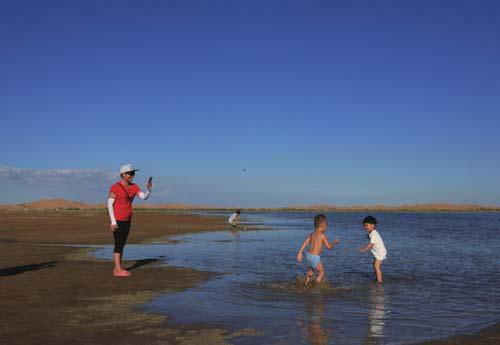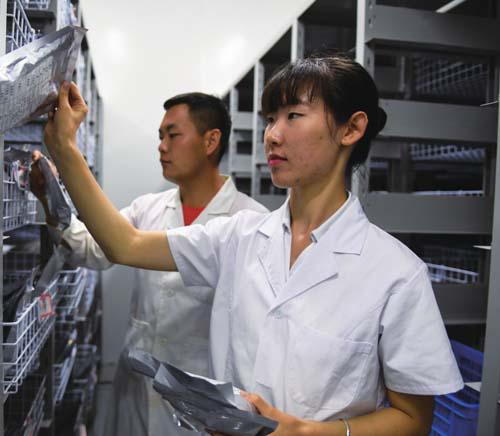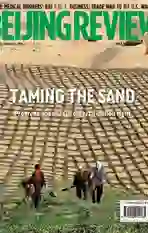A FRONTLINE IN THESAND
2018-09-19ByLiQing&LuYan
By Li Qing & Lu Yan


Mengke Dalai wanted to escape from the Kubuqi Desert where ecological degradation was making his life increasingly harsh. “The grassland became sandy as the grass disappeared. After that we struggled to continue with our way of life, even though generations of herdsmen had lived on this pasture before us,” he recalled. Finally, the ethnically Mongolian herdsman in Hanggin Banner in Ordos, north Chinas Inner Mongolia Autonomous Region, moved to a new community for herdspeople in the banner along with his fellow villagers in 2006. The relocation was part of a grassland restoration project launched by the local government.
Grazing was banned on the degraded pasture in the Kubuqi, the seventh largest desert in China, in a bid to restore the land. New green industries have also been created. “Everything has changed. The desert has begun to turn green and rainfall has increased,” Mengke Dalai said.
As one of many herdspeople now benefiting from the desert, Mengke Dalais life has dramatically improved. “People now envy us for our desert-turned-oasis,” he said.
The degradation of green land is one of the most severe environmental problems facing the world today. According to a recent report released by the United Nations Convention to Combat Desertification (UNCCD), desertification could result in economic losses worth $23 trillion worldwide in the future.
China, as a country with a large area of desert, has nearly 2.61 million square km of degraded land. But China has also been one of the most successful countries in combating desertification and has valuable experience to share with the international community on curbing the destructive process, Erik Solheim, UN Under Secretary General and Executive Director of the UN Environment Program, said on September 12, 2017.
The Kubuqi is a vivid example of desert greening.
Kubuqis practice
In a congratulatory message sent to the Sixth Kubuqi International Desert Forum in July 2017, President Xi Jinping said that China has always emphasized the prevention of desertification. Significant achievements have been made, which contribute to the construction of the nation and provide China with experience of ecological improvement which can benefit the international community.
The Kubuqi is located in Hanggin Banner, 800 km from Beijing, and the 18,600-squarekm desert is home to frequent sandstorms.
A four-pronged model involving combating desertification, restoring ecology, developing industry and alleviating poverty has been the key factor in the Kubuqis success. It was jointly established through policy guidance from the government, capital investment from enterprises, the participation of farmers and herdspeople and the innovation of technology. In the process of combating desertification, a system combining land reclamation, grassland farming, healthcare, tourism, photovoltaic power generation and other green industries has been developed and, in turn, is accelerating the progress of desertification control.
Elion Resources Group is one such enterprise leading the way in harnessing the potential of the desert. Wang Zhanyi, General Manager of the companys Brand Center, told Beijing Review that after more than 30 years of greening the desert, their notion of taming such landscapes has undergone a transformation from passiveness to taking the initiative.
Founded in 1988, Elion was previously a near-bankrupt saltworks on the edge of the Kubuqi. “It was in an isolated area where water, power, roads and communication were not easily accessible,” said Wang. Worsening degradation also became a huge obstacle to the companys development. In a fight for survival, Elion resolved to find a way to tackle the spread of the desert.
Elion has obtained more than 300 national technology patents to combat desertification, the result of research and innovation from a professional team. According to Wang, it now takes only 10 seconds to plant a tree in the Kubuqi, with big data utilized to guide the activities of afforestation without violating natures rules. In addition to progress on the ground, Elion has invested in the building of a plant germplasm bank to preserve endangered and rare species of plant.
Wang said that while desertification is a desperate problem, if tackled properly, it also can be seen as a good opportunity for the development of the local economy and to improve the life of local residents.
For example, the community where Mengke Dalai lives was built to improve the living conditions of people in need. Farmers and herdspeople were encouraged to move there, supported by the local government and Elion. In addition to a 50,000-yuan($7,278) living allowance and a 40-squaremeter house, the relocated households are able to buy more floor space at a discounted price.
Local residents also benefit from the growing eco-tourism industry in Hanggin Banner, which has begun to provide a large number of employment opportunities in recent years. According to a Xinhua News Agency report, in the past 10 years, tourist attractions in Ordos received nearly 10 million visitors and generated 2.46 billion yuan ($358 million) in profit.
“The government encourages us to study the experiences of other cities and improve our services,” said Mengke Dalai.
Monique Barbut, Executive Secretary of the UNCCD, said that the success of the Kubuqi is not only in the afforestation of its desert but in the increased wealth of local residents.
The changes that have taken place in the Kubuqi over the past three decades won recognition from international observers at the 2018 UN High-Level Political Forum on Sustainable Development.
According to a report on its achievements of the past 30 years released on June 29, Elion has invested more than 330 billion yuan ($48 billion) in desertification control, tackling the sand in more than 606,970 hectares of desert and leading 10,200 people in the Kubuqi and its surrounding areas out of poverty.
International cooperation
“We set up a green Belt and Road economic innovation center with the UN Environment Program in June 2017. Cooperation at the global level in ecology and anti-desertification is very welcome at the moment, so we organized a team to carry out the relevant work,” Wang said.
Wang also believes that the success of reforestation in the Kubuqi can provide valuable experience for regions with similar conditions. “Our achievements convey an important message to countries suffering from desertification: The desert can be a source of wealth. It can be tackled, developed and utilized,” he added.
The Kubuqi PPP (public-private partnerships) plus system is a unique collaborative model that has successfully achieved the balance between ecology and economy, rehabilitation and poverty reduction.
“Our model and experience have gradually been adopted in the anti-desertification efforts of other provinces and regions such as Xinjiang Uygur Autonomous Region, Tibet Autonomous Region and Gansu Province. Our experiences will gradually benefit countries along the Silk Road Economic Belt and the 21st-Century Maritime Silk Road (Belt and Road) in the future as well,” said Wang.
Many countries, such as Israel and Turkey, have their own merits in regard to combating desertification. “We are learning from their successful experiences and advanced technology, applying them to our own practice,” Wang said, emphasizing the importance of communication and exchange.
“China has proposed cooperation among countries along the Belt and Road in the prevention of desertification. It involves six key aspects: monitoring and planning, policy and regulation, technology and demonstration, information sharing, the strengthening of capability, and the preservation of world heritage,” Luo Bin, an official with the State Forestry Administration, said in an interview with People.cn.
Chinese solution
In September 2017, the 13th Session of the UNCCD Conference of the Parties (COP 13) was convened in Ordos. During the meeting, Zhang Hongwen, chief economist of Chinas State Forestry Administration, introduced Chinas established scientific and technological system for bringing the sands under control.
According to Zhang, a system for monitoring desertification was established after investigations into areas primarily made up of desert and rock. Technology models were also developed, consisting of rapid quicksand immobilization, the restoration of vegetation and an oasis-artery-forest protection system. At the same time, national standards, industrial regulations and local plans related to desertification control and degradation monitoring were released.
Zhang emphasized the importance of developing technology. China has promoted the application of techniques such as sand barriers, which can prevent the mobility of sand by covering the land with materials like hay and plants.
The adoption of an efficient and sustainable model to tackle desertification is also essential to success, according to Zhang. Various sections of Chinese society have been mobilized so as to tackle challenges on all fronts. Capital investment from enterprises and the participation of farmers and herdspeople are both crucial to greening the desert.
He added that the participation of different groups in the prevention and control of desertification brings more than just capital investment, but technology, innovation in the mobilization of social forces and even good morale as well. Local people can contribute to the activities and at the same time benefit from the achievements of afforestation.
According to the agenda proposed at the session, 2030 is the year by which the world should aim to halt desertification, restore degraded land and soil, and achieve a world without land degradation.
At the session, a cooperation system under the framework of the Belt and Road Initiative was formed between China and other countries including Algeria and Cambodia. The development strategy will be revised every five years to help realize the UN 2030 Agenda for Sustainable Development.
“Anti-desertification cooperation under the Belt and Road Initiative mainly functions in a bilateral way,” Luo noted. China has provided training for African, Middle Eastern and Central Asian countries and has shared technology and experience at the global level. Under the framework of the Belt and Road, China will invest more in projects in African countries. At the same time, more training will be conducted for the exchange of expertise and experience, and South-South cooperation will help to achieve the target of completely halting global land degradation by 2030.
Nezha El Ouafi, Moroccan Secretary of State for Sustainable Development, said that Morocco and China share a profound and steady partnership. “Although the climate in Morocco differs from Inner Mongolias, we can still learn a number of things from the Kubuqi model,” she said, adding that she hopes the fight against desertification can be a key area of cooperation between the two countries.
